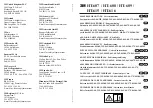
MAIN FEATURES AND OPERATION
Monitoring Section
•
11
•
Zero latency monitoring
The input signal from either microphone or instrument is converted to a digital signal and is sent to the
computer via a USB connection. It then goes into the music software application and is sent back for lis-
tening. Using the ASIO driver software installed earlier, the time delays this process causes are kept to a
minimum. It may however be annoying to the artist when making a new recording since this slight delay is
perceived as an ‘out of time’ feel, or if the delay is quite long an echo effect.
The SpeedIO has a zero latency monitoring feature whereby a knob is provided to balance the previously
recorded material with the live sound to be recorded.
There is also a knob, the LINE OUT LEVEL control (see page 9) to control the level of the signal going to
powered Loudspeakers. With control over the output level to the Loudspeakers, it is very quick to switch
between listening to a new recording (after for example a new vocal has been added) to going back to a
Headphones only monitoring situation for recording a further vocal.
The MONITOR Knob
This is used to balance the signal present at the HEADPHONES jack between the audio signal present at
the audio fed into the Input jacks and any Audio arriving via USB from the computer.
Fully counter-clockwise, only the Input signal can be heard. As the knob is turned clockwise, more and
more Output audio signal will be introduced until at the fully clockwise position, only the Output Audio from
the computer will be present.
The HEADPHONE LEVEL Knob
Use this to adjust the level of the signal sent to the HEADPHONE stereo jack.
The MONO Button
Normally, the signal heard at the HEADPHONES jack is a stereo image. The Input 1 signal is heard on the
left and the Input 2 signal is heard on the right. By pressing this front panel button, the HEADPHONE jack
mix will become monaural with both the Input 1 and Input 2 signals having a centre pan position in the
stereo field.
The SAMPLE RATE and POWER LEDs
The SAMPLE RATE LEDs indicate the sampling frequency of the Audio signal sent by the computer to the
SpeedIO. This sampling rate can usually be set within the computer music Audio sequencer application
and cannot be specified by the SpeedIO directly.
The POWER LED is lit to confirm that the SpeedIO is able to draw power from the USB port and is func-
tioning correctly.
SpeedIO v10.qxd 23/01/04 12:05 Page 11































